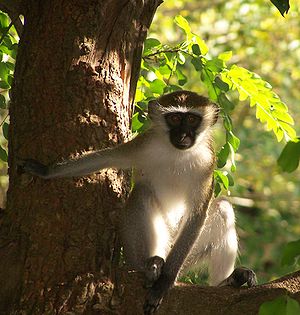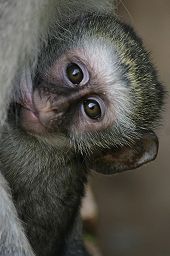- Vervet monkey
-
Vervet monkey[1] 
Vervet Monkey at Dar es Salaam, Tanzania Conservation status Scientific classification Kingdom: Animalia Phylum: Chordata Class: Mammalia Order: Primates Family: Cercopithecidae Genus: Chlorocebus Species: C. pygerythrus Binomial name Chlorocebus pygerythrus
F. Cuvier, 1821
Vervet Monkey range The vervet monkey (Chlorocebus pygerythrus), or simply vervet, is an Old World monkey of the family Cercopithecidae native to Africa. The term "vervet" is also used to refer to all the members of the genus Chlorocebus.
Contents
Taxonomic classification
The vervet monkey was previously classified as Cercopithecus aethiops. The vervet and malbrouck have often been considered conspecific, or as subspecies of the widespread grivet.[3]
There are five distinct subspecies of vervet monkey:[2]
- Chlorocebus pygerythrus excubitor
- Chlorocebus pygerythrus hilgerti from southern Kenya[4]
- Chlorocebus pygerythrus nesiotes
- Chlorocebus pygerythrus pygerythrus from South Africa, Botswana,[4][5] Lesotho and Swaziland[5]
- Chlorocebus pygerythrus rufoviridis from Mozambique[4] and Uganda[6] has a distinctly reddish coloured back which is darker towards the base of the tail.[7]
Physical description
The vervet monkey has a black face with a white fringe of hair, while the overall body colour is mostly grizzled-grey.[8] The males of all species have a pale blue scrotum and a red penis.[9] The species exhibits sexual dimorphism, the males are larger in weight and body length. Adult males weigh between 3.9 and 8.0 kilograms (8.6 and 18 lb), averaging 5.5 kilograms (12 lb), and have a body length between 420 and 600 millimetres (17 and 24 in), averaging 490 millimetres (19 in) from the top of the head to the base of the tail. Adult females weigh between 3.4 and 5.3 kilograms (7.5 and 12 lb) and average 4.1 kilograms (9.0 lb), and measure between 300 and 495 millimetres (12 and 19.5 in), averaging 426 millimetres (16.8 in).[7][10]
Behaviour
Social structure
The vervet monkey is diurnal and social; living in groups of up to 72.[11] There is a clear order of dominance among individuals within the group.
Alarm calls
The vervet monkey uses different sounds to warn of different types of predators. It has distinct calls to warn of the sighting of a leopard, a snake, or an eagle. These sounds are considered a proto-language by many ethologists.[who?]
The young appear to have an innate tendency to make these alarm calls, and adult monkeys seem to give positive reinforcement when the young make the right call, by repeating the alarm. Mothers have been reported to punish young giving the wrong call.[12]
Diet
The vervet monkey eats a wide range of fruits, figs, leaves, seeds and flowers. It also eats birds' eggs and young chicks, and insects (grasshoppers and termites). In human inhabited environments it will eat bread and various crops; especially maize.
A list of some natural food plants and part of the plant eaten, in South Africa:[7][13]
- Acacia erioloba - seeds and pods
- Aloe spp - nectar (flowers)
- Celtis africana - fruit
- Colophospermum mopane - seeds
- Deinbollia oblongifolia - fruit
- Euphorbia ingens - fruit
- Euphorbia tirucalli - fruit
- Ficus abutifolia - figs
- Ficus sur - figs
- Ficus sycomorus - figs
- Grewia caffra - fruit
- Harpephyllum caffrum - fruit
- Hyphaene coriacea - fruit
- Phoenix reclinata - fruit
- Protorhus longifolia - fruit
- Rhus chirindensis - fruit
- Sclerocarya birrea - fruit
- Strelitzia nicolai - soft parts of the flowers
- Ximenia caffra - fruit
- Ziziphus mucronata - fruit
Distribution and habitat
The vervet monkey ranges throughout much of Southern and East Africa, being found from Ethiopia, Somalia and extreme southern Sudan, to South Africa. It is not found west of the Great Rift Valley or the Luangwa River,[1] where it is replaced by the closely related malbrouck (C. cynosuros). The vervet monkey inhabits savanna, riverine woodland, coastal forest and mountains up to 4000 m (13,100 ft). They are adaptable and able to persist in secondary and/or highly fragmented vegetation, including cultivated areas, and sometimes are found living in both rural and urban environments.[2]
Introduced vervets also occur in Barbados, Saint Kitts, and Nevis. Dania Beach, Florida is also home to about 20 vervets. [14]
Conservation status
In spite of low predator populations in many areas where human development has encroached on wild territories, this species is killed by electricity pylons, vehicles, dogs, pellet guns, poison, and bullets and is trapped for traditional medicine, bush meat, and for biomedical research.[15] The vervet monkey has a complex and fragile social system, its persecution is thought to have affected troop structures and diminishing numbers.
Multiple organisations are involved in vervet monkey conservation.
In ancient history
This species was known in ancient Egypt including the Red Sea Mountains and the Nile Valley.[16] From fresco artworks found in Akrotiri on the Mediterranean island of Santorini there is evidence that the vervet monkey was known to the inhabitants of this settlement around 2000 BC; this fact is most noted for evidence of early contact between Egypt and Akrotiri.[17]
Gallery
-
Vervet monkeys in Samburu
-
Male Vervet Monkey at Lake Manyara National Park, Tanzania, showing blue scrotum.
-
Female and juvenile, Kruger Park, South Africa
References
- ^ a b Groves, C. (2005). "Chlorocebus pygerythrus". In Wilson, D. E., & Reeder, D. M, eds. Mammal Species of the World (3rd ed.). Baltimore: Johns Hopkins University Press. pp. 159. OCLC 62265494. ISBN 0-801-88221-4. http://www.bucknell.edu/msw3/browse.asp?id=12100508.
- ^ a b c Kingdon, J., Gippoliti, S., Butynski, T.M. & De Jong, Y. (2008). "Chlorocebus pygerythrus". IUCN Red List of Threatened Species. Version 2010.1. International Union for Conservation of Nature. http://www.iucnredlist.org/apps/redlist/details/136271. Retrieved 11 April 2010.
- ^ Kingdon, J. (1997). The Kingdom Guide to African Mammals. Academic Press Limited, London. ISBN 0-12-408355-2.
- ^ a b c Biodiversity occurrence data provided by: Field Museum of Natural History, Museum of Vertebrate Zoology, University of Washington Burke Museum, and University of Turku (Accessed through GBIF Data Portal, www.gbif.net, 2010-06-18)
- ^ a b Cillie', G.E.B. (1992). Pocket Guide to Southern African Mammals. ISBN 0 627 01686 3.
- ^ (Isbell & Enstam under review)
- ^ a b c Skinner, J.D. & Smithers, R.H.N. (1990). The mammals of the southern African subregion (2nd ed.). Pretoria (South Africa): University of Pretoria. pp. 771. ISBN 0 86979 802 2.
- ^ Stuart C. and Stuart T. (1997). Field Guide to the Larger Mammals of Africa. ISBN 1 86825 757 6
- ^ Fedigan L, Fedigan LM. (1988). Cercopithecus aethiops: a review of field studies.. Cambridge (UK): Cambridge University Press. pp. 389–411.
- ^ Napier, P.H. (editor) (1981). "Part II: Family Cercopithecidae, Subfamily Cercopithecinae". Catalogue of primates in the British Museum (Natural History) and elsewhere in the British Isles. London: British Museum (Natural History). pp. 203.
- ^ Pasternak G. et al., (2011). Population structure, habitat use and diet in a southern, semi desert vervet monkey. 34th meeting of the American Society of Primatologists
- ^ Seyfarth, R. M., Cheney, D. L. and Marler, P. 1980. “Monkey responses to three different alarm calls: evidence of predator classification and semantic communication.” Science 210: 801-803
- ^ Pooley, E. (1993). The Complete Field Guide to Trees of Natal, Zululand and Transkei. ISBN 0 620 17697 0.
- ^ Freimer, N.; Dewar, K.; Kaplan; Fairbanks, L. (pdf). The Importance of the Vervet (African Green Monkey) as a Biomedical Model. National Human Genome Research Institute. http://www.genome.gov/Pages/Research/Sequencing/SeqProposals/TheVervetMonkeyBiomedicalModel.pdf. Retrieved 2011-01-29.
- ^ Foggo, Daniel (2008-07-06). "Germ warfare fear over African monkeys taken to Iran". The Times (London). http://www.timesonline.co.uk/tol/news/world/africa/article4276460.ece. Retrieved 2010-03-27.
- ^ Moeyersons, J., Vermeersch, P. M., Beeckman, H. & Van Peer, P. (1999). "Holocene environmental changes in the Gebel Umm Hammad, Eastern Desert, Egypt: Dry cave deposits and their palaeoenvironmental significance during the last 115 ka, Sodmein Cave, Red Sea Mountains, Egypt". Geomorphology 26 (4): 297–312. doi:10.1016/S0169-555X(98)00067-1.
- ^ Michael Hogan, C. (2007-12-13). "Akrotiri". Modern Antiquarian. http://themodernantiquarian.com/site/10846/akrotiri.html#fieldnotes. Retrieved 2008-07-13.
External links
- Vervet Monkey Foundation
- Vervet Monkey calls
- BBC story: Vervet Monkeys raid farms
- Darwin Primate Group
- Vervet Monkey, Primate Info Net
- Computerized atlas of Vervet brain MRI
Categories:- IUCN Red List least concern species
- Mammals of Africa
- Cercopithecine monkeys
- Animals described in 1821
- Urban animals
Wikimedia Foundation. 2010.










